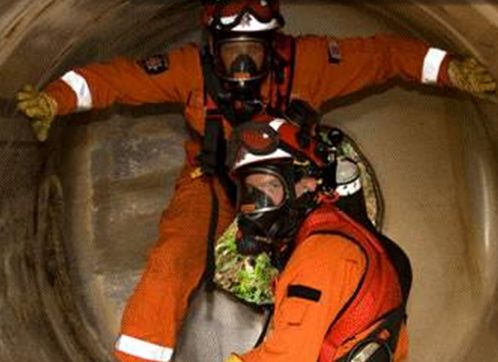Respiratory Protection
If there is even a remote possibility of other atmospheric contaminants, even though monitoring equipment readings appear to be within the normal ranges, rescuers should still use appropriate respiratory protection. Play it safe: Do not use air purifying respirators for confined space rescue.
Figure 2 below shows a rescue team wearing air-supplying respirators inside a confined space, in this case a tank.
If a hazardous atmosphere exists in the confined space, such as toxic gases, employees may use an appropriate air-purifying respirator. However, if the confined space lacks oxygen, an air-purifying respirator will do no good - there is no supply of oxygen to breathe in the first place. In this situation, an entrant would need to wear an air-supplying respirator. An air-supplying respirator will supply breathable air and protect the entrant from breathing in hazardous air from the confined space atmosphere.
After being overcome by low oxygen and sewer gases, a volunteer firefighter died while climbing down into a sewer maintenance to rescue a village utility worker. The utility worker had entered the manhole to investigate a reported sewer problem and was overcome by low oxygen and sewer gases.
The incident occurred behind the fire station in an underground sewer line that ran under the fire station. The local utility company contacted the chief of the village's volunteer fire department and requested that a piece of fire apparatus be moved out of the station so they would not block it in while accessing a maintenance hole.
The fire chief responded to the station to move the fire apparatus so it would not be blocked by the utility trucks. The firefighter arrived at the station to assist. A utility worker entered the maintenance hole behind the station to clear a sewer backup and was overcome by a lack of oxygen and sewer gases and then fell unconscious inside the manhole. The firefighter then entered the maintenance hole without any personal protective equipment to help the utility worker and was also overcome by the low oxygen level and sewer gases. The firefighter and the utility worker were later removed from the sewer maintenance hole by fire department personnel and transported to a local hospital, where they were pronounced dead.
The medical examiner reported the cause of death as asphyxia due to low oxygen and exposure to sewer gases.
Key Recommendations:
- Ensure that workers are properly trained and equipped to recognize the hazards of and participate in a confined space technical rescue operation.
- Ensure that standard operating procedures regarding technical rescue capabilities are in place and a risk benefit analysis is performed to protect the safety of all responders.
- Ensure that an effective incident management system is in place that supports technical rescue confined space operations.
- Ensure that a safety officer properly trained in the technical rescue field being performed is on scene and integrated into the command structure.
Knowledge Check Choose the best answer for the question.
3-7. Testing equipment indicates a lack of oxygen in the confined space. What type of respirator is required for entry?
You forgot to answer the question!


